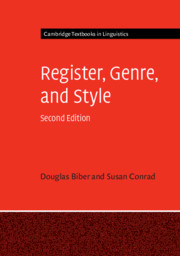Book contents
- Register, Genre, and Style
- Cambridge Textbooks in Linguistics
- Register, Genre, and Style
- Copyright page
- Contents
- Figures
- Tables
- Acknowledgments
- 1 Registers, Genres, and Styles: Fundamental Varieties of Language
- Part I Analytical Framework
- Part II Detailed Descriptions of Registers, Genres, and Styles
- Part III Larger Theoretical Issues
- Book part
- References
- Index
- References
References
Published online by Cambridge University Press: 08 May 2019
- Register, Genre, and Style
- Cambridge Textbooks in Linguistics
- Register, Genre, and Style
- Copyright page
- Contents
- Figures
- Tables
- Acknowledgments
- 1 Registers, Genres, and Styles: Fundamental Varieties of Language
- Part I Analytical Framework
- Part II Detailed Descriptions of Registers, Genres, and Styles
- Part III Larger Theoretical Issues
- Book part
- References
- Index
- References
- Type
- Chapter
- Information
- Register, Genre, and Style , pp. 368 - 401Publisher: Cambridge University PressPrint publication year: 2019



